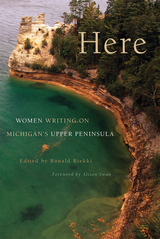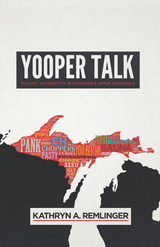4 books about Upper Peninsula (Mich.)

And Here
100 Years of Upper Peninsula Writing, 1917–2017
Ronald Riekki
Michigan State University Press, 2017
Upper Peninsula literature has traditionally been suppressed or minimized in Michigan anthologies and Michigan literature as a whole. Even the Upper Peninsula itself has been omitted from maps, creating a people and a place that have become in many ways “ungeographic.” These people and this place are strongly made up of traditionally marginalized groups such as the working class, the rural poor, and Native Americans, which adds even more insult to the exclusion and forced oppressive silence. And Here: 100 Years of Upper Peninsula Writing, 1917–2017, gives voice to Upper Peninsula writers, ensuring that they are included in Michigan’s rich literary history. Ambitiously, And Here includes great U.P. writing from every decade spanning from the 1910s to the 2010s, starting with Lew R. Sarett’s (a.k.a. Lone Caribou) “The Blue Duck: A Chippewa Medicine Dance” and ending with Margaret Noodin’s “Babejianjisemigad” and Sally Brunk’s “KBIC.” Taken as a whole, the anthology forcefully insists on the geographic and literary inclusion of the U.P.—on both the map and the page.
[more]

Cold
John Smolens
Michigan State University Press, 2017
Internationally acclaimed, Cold takes us deep into a harsh, frozen world, where love, greed, and the promise of a second chance compel six people toward a chilling and inevitable reckoning.
In the frozen reaches of Michigan’s Upper Peninsula, fierce winter storms hit without warning. The white opacity of one such blizzard allows Norman Haas to walk away from his prison work detail. Dangerously close to freezing to death, Norman is given shelter by Liesl Tiomenen, a middle-aged woman who lives in a house she and her late husband built in the woods. Armed with a rifle, she tries to turn him in, but when they set out on snowshoes, she suffers a fall, allowing him to flee again. Thus begins Norman’s journey back to his past, back to the woman he loved who betrayed him, back to the brother who helped put him away, back to a dangerous web of family allegiances, deceptions, and intrigue.
After finding Liesl injured and abandoned in the woods, Yellow Dog Township’s sole full-time law enforcement officer Del Maki pursues Norman through a storm of mythic proportions.
In the frozen reaches of Michigan’s Upper Peninsula, fierce winter storms hit without warning. The white opacity of one such blizzard allows Norman Haas to walk away from his prison work detail. Dangerously close to freezing to death, Norman is given shelter by Liesl Tiomenen, a middle-aged woman who lives in a house she and her late husband built in the woods. Armed with a rifle, she tries to turn him in, but when they set out on snowshoes, she suffers a fall, allowing him to flee again. Thus begins Norman’s journey back to his past, back to the woman he loved who betrayed him, back to the brother who helped put him away, back to a dangerous web of family allegiances, deceptions, and intrigue.
After finding Liesl injured and abandoned in the woods, Yellow Dog Township’s sole full-time law enforcement officer Del Maki pursues Norman through a storm of mythic proportions.
[more]

Here
Women Writing on Michigan's Upper Peninsula
Ronald Riekki
Michigan State University Press, 2015
How does place impact prose? Here: Women Writing on Michigan’s Upper Peninsula explores that very question, drawing on the work of Upper Peninsula authors past and present to create a vibrant kaleidoscope of voices and experiences. Bame-wa-wa-ge-zhik-aquay, Janet Loxley Lewis, Lorine Niedecker, Catie Rosemurgy, and thirty-one other authors important to the region appear in this exceptional and diverse volume. In poetry (“Spring” by Beverly Matherne, “For Those Who Dream of Cranes” by Elinor Benedict, and “Skin on Skin” by Sally Brunk), short fiction (“North Country” by Roxane Gay, “For the Healing of All Women” by April Lindala, and “Winter Mines” by Sharon Dilworth), and novel excerpts (from Once on This Island by Gloria Whelan, South of Superior by Ellen Airgood, and Dandelion Cottage by Carroll Watson Rankin), the unique character of the U.P. materializes on the page. The book also shines a spotlight on powerful emerging voices such as Lisa Fay Coutley, Charmi Keranen, and Saara Myrene Raappana. The first of its kind, this is an anthology for all seasons, an homage to the rich literary heritage of the region.
[more]

Yooper Talk
Dialect as Identity in Michigan's Upper Peninsula
Kathryn A. Remlinger
University of Wisconsin Press, 2019
The Upper Peninsula of Michigan—known as “the U P”—is historically, geographically, and culturally distinct. Struggles over land, labor, and language during the last 150 years have shaped the variety of English spoken by resident Yoopers, as well as how they are viewed by outsiders—and themselves. Drawing on sixteen years of fieldwork, including interviews with seventy-five lifelong residents of the UP, Kathryn Remlinger examines how the idea of a unique Yooper dialect emerged. Considering UP English in relation to other regional dialects and their speakers, she looks at local identity, literacy practices, media representations, language attitudes, notions of authenticity, economic factors, tourism, and contact with non-English immigrant and Native American languages. The book also explores how a dialect becomes a recognizable and valuable commodity: Yooper talk (or “Yoopanese”) is emblazoned on t-shirts, flags, postcards, coffee mugs, and bumper stickers.
[more]
READERS
Browse our collection.
PUBLISHERS
See BiblioVault's publisher services.
STUDENT SERVICES
Files for college accessibility offices.
UChicago Accessibility Resources
home | accessibility | search | about | contact us
BiblioVault ® 2001 - 2024
The University of Chicago Press









